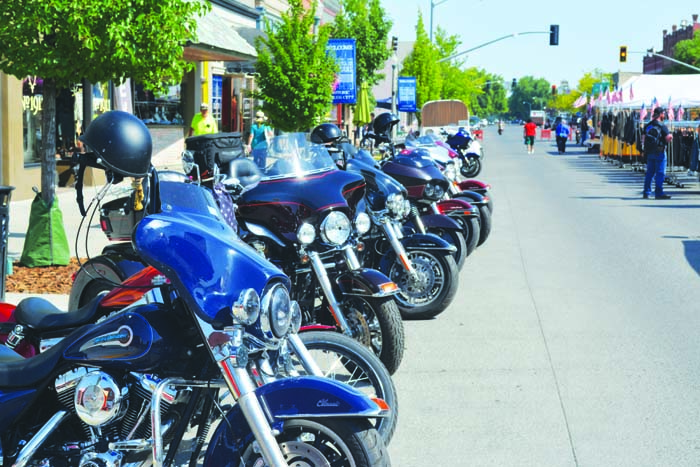COLUMN: Pondering the future of our scorched forests
Published 1:45 pm Thursday, December 30, 2021
A little more than six years after the cataclysmic smoke cloud towered over southern Baker County, fouling the summer air and turning sunsets into blood-red spectacles both beautiful and depressing, I walked through a tiny section of the scorched landscape.
In a few places I saw about as much green, in the form of healthy juvenile ponderosa pines, as I did the black skeletons of trees that perished in August 2015.
Such are the vagaries of fire.
Even a blaze as big as the 104,000-acre Cornet-Windy Ridge fire, which raced across the Dooley Mountain country, isn’t the comprehensive force of a destruction that it can seem while its embers are falling a dozen miles away.
My short hike, on the afternoon of the day after Thanksgiving, followed the course of a seasonal stream east of the Dooley Mountain Highway, a few miles down the Baker side from the summit.
As I climbed through this narrow gulch, clambering over the occasional black-barked pine log and detouring around boulders that have tumbled from outcrops on the largely barren hills, I thought both about the power of fire and the resiliency of the land.
The flames’ speed on those hot, dry and blustery days in 2015 belied the reality that just 26 years earlier, which is no great span in wildfire intervals, another lightning-sparked blaze had charred almost every tree on those steep slopes.
It turned out that the subsequent crop of ponderosa pines, some planted and some seeding naturally after the 1989 Dooley Mountain fire, were about as vulnerable to a 21st century inferno as the thickets of mature firs and pines were to that earlier blaze.
The 20,000-acre Dooley Mountain fire was a milestone, the biggest in Baker County since the 1939 Big Cow fire in the Unity country.
The Cornet-Windy Ridge fire was five times as large, forcing us to readjust our perspective.
Yet neither fire killed every tree in its path.
The many hikes I’ve made through the burned ground since 2015 have led me to ponder not only the usual questions — will Dooley Mountain ever again look much as it did before 1989, and if so, when? — but the more troubling matter of whether a forest will ever return, in any form, to some of the area.
I’ve talked with experts several times, between 1989 and 2015, and then after the Cornet-Windy Ridge fire, and I learned that this part of Baker County is a pretty precarious place for any local conifer other than the western juniper, that great colonizer of marginal lands and survivor of drought.
Dooley Mountain’s problems, when it comes to supporting pines and firs, are multiple.
The soil, generally speaking, is poor, an ashy sort derived from the rhyolite lava erupted from volcanoes around 12 million to 16 million years ago.
(These are the distinctive rocks, ranging from nearly white to a conspicuous pink, that are common in the Dooley Mountain area.)
The climate is not ideal, either.
Dooley Mountain’s elevation is middling by local standards. Most of the area is below 6,000 feet, so average temperatures are higher, and annual precipitation lower, than in, say, the Elkhorns or the Wallowas.
The U.S. Forest Service and Bureau of Land Management have planted tens of thousands of seedlings on the mountain in the aftermath of both the 1989 and 2015 blazes. Survival rates for these baby trees has been less than robust in some areas, particularly on the south- and west-facing slopes that are most exposed to the desiccating sun.
The Dooley Mountain country marks the transition zone between the conifer forests of the Blue Mountains to the west, and the lower sagebrush lands to the east that extend well into Idaho.
The two big fires somewhat obscured this boundary by killing so many of the pines and firs. From some vantage points — along Interstate 84 southeast of Baker City, for instance — it almost looks as though the forests give way to sage along the general route of Highway 245, which crosses Dooley Summit and descends to the Burnt River Valley.
This is an illusion, at least based on the extent of the conifer forests prior to the fires. Thick stands of pines and firs grew on the ridges and in the valleys for several miles east of Dooley Summit.
In some places they still do.
Which brings me back to the point about the curious path that flames can trace.
Sometimes the explanation is obvious even to a layperson like me. During my post-Thanksgiving hike I noticed that the larger number of ponderosa pines — all of which started growing after the 1989 fire, based on their height of up to 15 feet or — are growing in thickets on the north-facing slopes near the bottom of the gulch.
These areas tend to be relatively cool and wet since they’re less exposed to sunlight. And I imagine such places were somewhat sheltered from the flames in 2015, perhaps because the winds were a bit less gusty.
But I noticed too that scattered clumps of pines, all about the same size, also are growing on the opposite side of the gulch, on a steep, south-facing slope.
That these trees also survived the inferno six years ago seems to me more happenstance than anything else.
I hope these islands of green will continue to thrive, the foundation of a future forest that once again will drape Dooley Mountain in the living green.
With climate change likely to make the place ever less hospitable, this prospect probably is tenuous.
I’ll likely not be around to see the conclusion to this chapter of a story that dates back many millennia.
But regardless, I’ll be pulling for the pines.
Jayson Jacoby is editor of the Baker City Herald.







